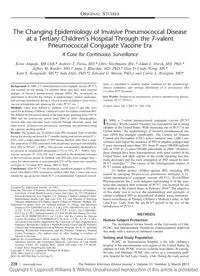
2012 Human Coronavirus in Young Children Hospitalized for Acute Respiratory Illness and Asymptomatic Controls PDF
Preview 2012 Human Coronavirus in Young Children Hospitalized for Acute Respiratory Illness and Asymptomatic Controls
ORIGINAL STUDIES The Changing Epidemiology of Invasive Pneumococcal Disease at a Tertiary Children’s Hospital Through the 7-valent Pneumococcal Conjugate Vaccine Era A Case for Continuous Surveillance Krow Ampofo, MB ChB,* Andrew T. Pavia, MD,* Chris Stockmann, BSc,* Adam L. Hersh, MD, PhD,* Jeffrey M. Bender, MD,† Anne J. Blaschke, MD, PhD,* Hsin Yi Cindy Weng, MS,* Kent E. Korgenski, MS,*‡ Judy Daly, PhD,*‡ Edward O. Mason, PhD,§ and Carrie L. Byington, MD* Background: In 2000, a 7-valent pneumococcal conjugate vaccine (PCV7) was licensed for use among US children. Many sites have since reported changes in invasive pneumococcal disease (IPD). We recognized an opportunity to describe the changes in epidemiology, clinical syndromes, and serotype distribution during a 14-year period including 4 years before vaccine introduction and spanning the entire PCV7 era. Methods: Cases were defined as children �18 years of age who were cared for at Primary Children’s Medical Center for culture-confirmed IPD. We defined the prevaccine period as the time frame spanning from 1997 to 2000 and the postvaccine period from 2001 to 2010. Demographics, clinical data, and outcomes were collected through electronic query and chart review. Streptococcus pneumoniae serotyping was performed using the capsular swelling method. Results: The median age of children with IPD increased from 19 months during the prevaccine period to 27 months during postvaccine period (P � 0.02), with a larger proportion of IPD among children older than 5 years. The proportion of IPD associated with pneumonia increased substantially from 29% to 50% (P � 0.001). This increase was primarily attributable to an increase in complicated pneumonia (17% to 33%, P � 0.001). Non- vaccine serotypes 7F, 19A, 22F, and 3 emerged as the dominant serotypes in the postvaccine period. In children with IPD who were younger than 5 years, for whom vaccine is recommended, 67% of the cases were caused by serotypes in 13-valent PCV during 2005 to 2010. Conclusions: After PCV7 was introduced, significant changes in IPD were noted. One-third of IPD occurred in children older than 5 years, who were outside the age-group for which PCV is recommended. Continued surveil- lance is warranted to identify further evolution of the epidemiology, clinical syndromes, and serotype distribution of S. pneumoniae after 13-valent PCV licensure. Key Words: Streptococcus pneumoniae, invasive pneumococcal disease, serotype, PCV7, PCV13 (Pediatr Infect Dis J 2012;31: 228–234) I n 2000, a 7-valent pneumococcal conjugate vaccine (PCV7 �Prevnar�; Wyeth Lederle Vaccine) was licensed for use in young children in the United States. With increasing use of PCV7 in the United States,1 the epidemiology of invasive pneumococcal dis- ease (IPD) has changed significantly. The Centers for Disease Control and Prevention (CDC) active bacterial core (ABC) sur- veillance sites report the incidence of IPD in children younger than 5 years decreased more than 70% from 95 cases/100,000 individ- uals in 1999 to 23 cases/100,000 individuals in 2004.2 However, these changes have been heterogeneous, with some centers in the United States and other regions of the world reporting less dra- matic decreases and the early emergence of IPD caused by non- PCV7 serotypes.2–7 The causes of the heterogeneous impact of PCV7 remain unknown. To further protect children against IPD, including IPD caused by emerging Streptococcus pneumoniae serotypes, a 13- valent pneumococcal conjugate vaccine (PCV13; Wyeth/Pfizer Pharmaceuticals Inc.), with antigens representing 6 of the sero- types that emerged after licensure of PCV7, was licensed for use in children in the United States in February 2010.8 The objective of this study was to review the epidemiology and serotypes of culture-confirmed IPD in hospitalized children using laboratory- based surveillance at Primary Children’s Medical Center, in Salt Lake City, Utah, from the pre-PCV7 period to the eve of the introduction of PCV13. METHODS Human Subject Protection The institutional review boards of the University of Utah, PCMC, and Intermountain Healthcare (Intermountain) approved this study with a waiver of informed consent. Setting and Study Population PCMC, an Intermountain hospital, is the only children’s hospital in the intermountain west region of the United States. In addition to Utah, PCMC receives referrals from Idaho, Wyoming, Nevada, and Montana. PCMC also serves as a community pedi- atric hospital for Salt Lake County, Utah. During the study period, Accepted for publication October 18, 2011. From the *Division of Pediatric Infectious Diseases, Department of Pediatrics, University of Utah Health Sciences Center, Salt Lake City, UT; †Pediatrics, Kaiser Permanente, Los Angeles, CA; ‡Primary Children’s Medical Center, Intermountain Health Care, Salt Lake City, UT; and §Section of Infectious Diseases, Department of Pediatrics, Baylor College of Medicine, Houston, TX. Supported by grants from the National Institute of Allergy and Infectious Diseases (U01A1082482) (to K.A., C.L.B.), (U01 AI074419-01) (to C.L.B., A.J.B., A.T.P.), (U01AI082184-01) (to A.T.P., A.J.B.), 1K23-AI079401- 01A1 (to A.J.B.); National Institute of Child Health and Human Develop- ment (K-24 HD047249-01A1) (to C.L.B.); and the Centers for Disease Control Prevention (U18-IP000303-01) (to K.A., C.L.B., A.T.P., A.J.B.). This project was further supported by the University of Utah, Department of Pediatrics through the Children’s Health Research Center and the Pediatric Clinical and Translational Research Scholars Program, the H. A. and Edna Benning Presidential Endowment, and the Primary Children’s Medical Center Foundation. The authors have no other funding or conflicts of interest to disclose. Address for correspondence: Krow Ampofo, MB, ChB, Division of Pediatric Infectious Disease and Geographic Medicine, University of Utah Health Sciences Center, 295 Chipeta Way, 2S010, Salt Lake City, UT 84108. E-mail:
